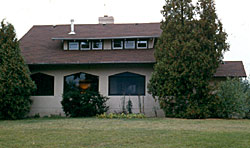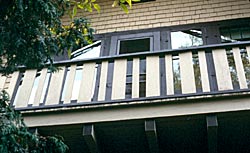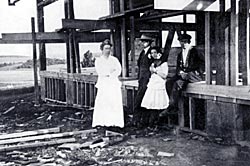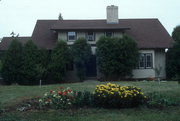Commons, John R., House
1645 Norman Way, Madison, Dane County
Designer: Cora Tuttle
Date of construction: 1913
John and Ella Commons named their hilltop bungalow "Hocheera," said to be a Ho-Chunk (Winnebago) word meaning "welcome." When the house was constructed in 1913 it was located in the midst of farmland, well beyond the limits of the city of Madison. The wood-frame building is sheathed with shingles on its upper story, while the first floor is covered with stucco. The most prominent feature of the house is a forty-foot long porch across the front of the house, whose pentagonal openings provide a view of Lake Mendota in the distance. The house is the largest residence designed by Madison designer Cora Tuttle, who is credited with introducing bungalows to the city.
John Commons (1863-1945) was an author of progressive social legislation, a pioneer in the fields of labor history and labor relations, economics, and an inspirational teacher to a generation of economics students. In 1904 he came to teach at the University of Wisconsin and remained on the faculty for 30 years. Commons' legislative and public policy contributions were the result of the relationship between the University and the Progressive Party administration of Governor Robert La Follette. As part of the "Wisconsin Idea" the state government called upon University of Wisconsin faculty to provide advice and recommendations. In this capacity, Commons drafted new social legislation, including those for civil service reform and the regulation of public utilities. Commons was also involved in Wisconsin's enactment of the nation's first Unemployment Insurance Law in 1932. Because of social reformers like Commons, Wisconsin became a laboratory for progressive innovations.
The house is a private residence and is not open to the public. Please respect the privacy of the owners.
|





